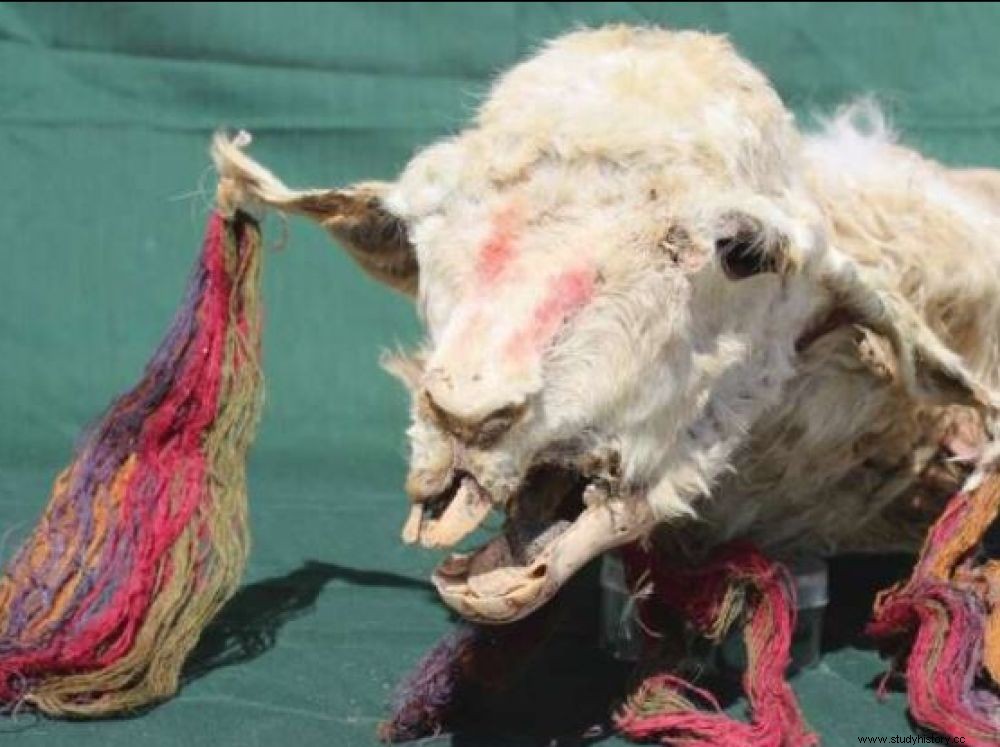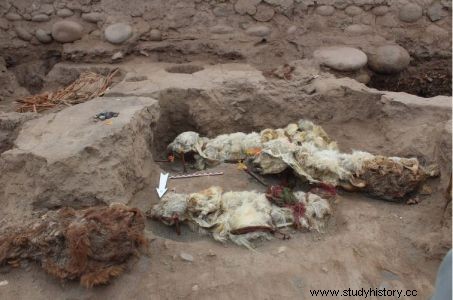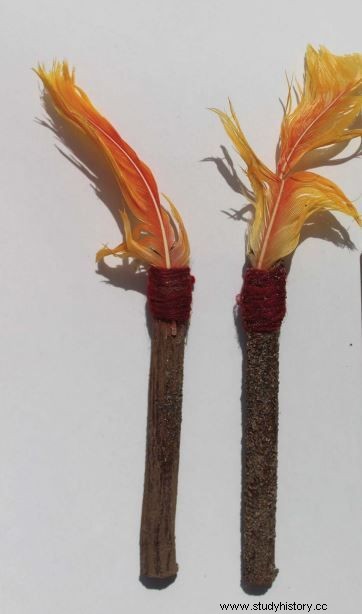Richly decorated animals, found sacrificed in southern Peru, highlight Inca rituals.

Lamas sacrificed 600 years ago found in an exceptional state of preservation at the archaeological site of Tambo Viejo, in Peru.
A warm wind blew on their fleece still present despite six centuries of burial... Unheard of! Found buried, their muzzles covered with red ocher lines, long cords colored red, green, yellow and mauve attached to their ears, buried llamas, it seems, alive during an Inca ritual, have were discovered for the first time in Peru in an astonishing state of preservation.

The sacrificed llamas as discovered by archaeologists. Credits:Lidio Valdez / Antiquity
Llamas were among the most important sacrificial offerings adopted by the Incas
Along with human beings… these domesticated animals were among the most important sacrificial offerings adopted by the Incas. Four llamas with astonishingly well-preserved organic remains have thus been unearthed at the archaeological site of Tambo Viejo, in the Acari Valley, on the southern coast of Peru, as reported by the magazine Antiquity . Adorned with shimmering ornaments, three white llamas and a brown llama were sacrificed 600 years ago. According to the authors of the scientific publication, these ritual practices served to strengthen the ties that the Incas maintained with the inhabitants of the newly conquered regions, at the time of the territorial expansion of the empire of Tahuantisuyo . "All these ceremonies allowed the Incas to legitimize their presence in the Acari Valley" , said Lidio Valdez, a researcher at the University of Calgary (Canada), the lead author of the study. Very formalized rituals that could be accompanied by songs, prayers and dances.
A warm wind blew on their fleece still present despite six centuries of burial... Unheard of! Found buried, their muzzles covered with red ocher lines, long cords colored red, green, yellow and mauve attached to their ears, buried llamas, it seems, alive during an Inca ritual, have were discovered for the first time in Peru in an astonishing state of preservation.

The sacrificed llamas as discovered by archaeologists. Credits:Lidio Valdez / Antiquity
Llamas were among the most important sacrificial offerings adopted by the Incas
Along with human beings… these domesticated animals were among the most important sacrificial offerings adopted by the Incas. Four llamas with astonishingly well-preserved organic remains have thus been unearthed at the archaeological site of Tambo Viejo, in the Acari Valley, on the southern coast of Peru, as reported by the magazine Antiquity . Adorned with shimmering ornaments, three white llamas and a brown llama were sacrificed 600 years ago. According to the authors of the scientific publication, these ritual practices served to strengthen the ties that the Incas maintained with the inhabitants of the newly conquered regions, at the time of the territorial expansion of the empire of Tahuantisuyo . "All these ceremonies allowed the Incas to legitimize their presence in the Acari Valley" , said Lidio Valdez, a researcher at the University of Calgary (Canada), the lead author of the study. Very formalized rituals that could be accompanied by songs, prayers and dances. Later, in the 16th century, ethnographic accounts of the Spanish conquerors amply described these scenes of sacrifices which could sometimes reach as far as the immolation of 100 lamas, in particular to favor the arrival of the rains. But real holocausts also took place with thousands of animals. The Incas worshiped a large number of deities to which they periodically consecrated offerings. "Those of the lamas of Tambo Viejo were not found in funerary contexts, but in domestic spaces" , said Lucie Dausse, archaeo-anthropologist at the ArchAm Laboratory, Archeology of the Americas (UMR 8096), of the University of Paris1-Panthéon Sorbonne, co-signatory of the article, joined by Sciences et Avenir. In Tambo Viejo, these sacrifices would have been intended for the creator god of the Incas, Viracocha as well as that of the Sun, Tayta Inti. In the past, the Spanish chronicler Barnabé Cobo (1582-1657) had already described the care that the Incas took in choosing the color of the lamas' robes. The animals were indeed selected according to the deities for which they were intended. They had to be irreproachable, without stains or particular marks. In Tambo Viejo, the young males sacrificed, -newborn babies barely a few months old-, were of a perfect uniform color.

These brightly colored feathers had been placed on top of one of the buried llamas. Credits:Lidio Valdez/Antiquity
Ritual practices to be compared with the sacrifices of living human beings
The Antiquity article specifies that during the examination of the llamas, no trace of cutting at the level of the throat or the diaphragm - which could have indicated cardiectomies - was found, suggesting that these animals could have been buried alive. A hypothesis reinforced by the presence of hindrances at the level of the legs. These ritual practices are to be compared with the sacrifices of living human beings, in particular children, carried out during ceremonies known as Capacocha . Associated with camelids, small guinea pigs (cuy , in Quechua) also carrying colorful decorations, were also sacrificed at Tambo Viejo. Sometimes in connection with handfuls of black beans, and orange feathers of tropical birds used as markers, these just deposited above the animal remains. The radiocarbon datings carried out place these sacrifices between 1432 and 1459. That is about a century before the arrival of the first Spaniards in 1532.
